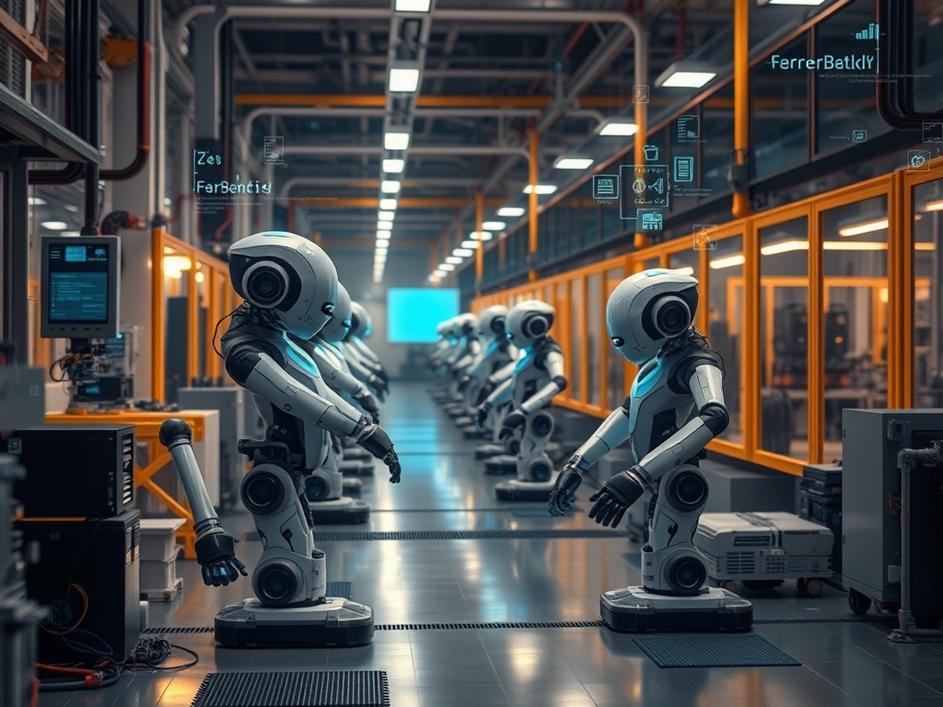


We are a digital agency helping businesses develop immersive, engaging, and user-focused web, app, and software solutions.
2310 Mira Vista Ave
Montrose, CA 91020
2500+ reviews based on client feedback

What's Included?
ToggleThink about a world where every smart device, every robot on a factory floor, and every automated system can think and react instantly, without waiting for data to travel to a faraway cloud server. That future is getting closer, and companies like Advantech are leading the way. They just announced some big new steps in what’s called ‘Edge AI.’ Simply put, Edge AI means bringing the brainpower of artificial intelligence directly to where the work happens – on the device itself, at the ‘edge’ of the network. This isn’t just a minor upgrade; it’s a fundamental shift in how we build and use intelligent systems, especially in areas like robotics and industrial automation. What Advantech is doing, powered by Qualcomm’s advanced ‘Dragonwing’ technology, could change a lot of things, making machines smarter, faster, and more independent than ever before. It’s about putting powerful AI right where it’s needed most, cutting out delays and opening up a whole new world of possibilities for how technology can help us.
You might wonder why we can’t just keep doing all our AI processing in big data centers, far away. Well, there are a few good reasons. First, speed. When a robot on an assembly line needs to make a decision in milliseconds, or a self-driving vehicle has to spot something unexpected right now, sending data all the way to a cloud and back just isn’t fast enough. Edge AI lets these machines react instantly. Second, reliability. What happens if the internet goes down? If your AI is on the edge, it keeps working. If it’s in the cloud, everything stops. Third, privacy and security. Many industries, like healthcare or defense, deal with very sensitive information. Keeping that data processed locally, on the device, means it doesn’t have to travel over networks where it could be vulnerable. It’s much safer. So, Edge AI isn’t just a fancy new term; it’s a practical solution to real-world problems, making systems more responsive, more robust, and more secure. It’s about making smart tech work better in the messy, unpredictable real world, especially in places like busy factories or remote energy sites where every second and every piece of data counts.
No great technological leap happens in a vacuum, and Advantech isn’t doing this alone. They’re working with Qualcomm, a company well-known for making the chips that power many of our smartphones. Qualcomm’s ‘Dragonwing’ platform is what’s giving Advantech’s new solutions their intelligent punch. Think of Dragonwing as the high-performance engine for these Edge AI systems. Qualcomm has a lot of experience making powerful processors that can do complex tasks while also being very energy efficient. This is super important for edge devices, which often run on limited power and need to operate in places without easy access to big cooling systems. By teaming up with Qualcomm, Advantech gets access to top-tier processing power specifically designed to handle intense AI calculations right there on the device. It means these new solutions can tackle harder problems, process more data, and run sophisticated AI models without needing a constant connection to the cloud or drawing huge amounts of power. This partnership is a smart move, combining Advantech’s industrial expertise with Qualcomm’s chip-making prowess.
So, where will we see these new Edge AI solutions make the biggest difference? Robotics and automation are definitely at the top of the list. Imagine a factory where robots don’t just follow pre-programmed paths but can actually ‘see’ and ‘understand’ their environment in real-time. They could adapt to changes on the fly, pick up different items even if they’re not perfectly placed, or spot a defect on a product with a sharp eye. In warehouses, automated guided vehicles (AGVs) could navigate complex routes, avoid unexpected obstacles, and optimize their paths instantly, all without a human telling them what to do. This isn’t just about making robots faster; it’s about making them smarter, more flexible, and able to handle situations that aren’t perfectly predictable. For businesses, this means more efficient operations, fewer errors, and a big step towards fully autonomous systems that can truly think for themselves. It takes the idea of ‘smart factory’ to a whole new level, where machines are not just tools, but active, intelligent participants in the production process.
One of the most exciting, and perhaps surprising, aspects of this announcement is the focus on Generative AI at the edge. Most of us think of Generative AI, like tools that write text or create images, as needing massive cloud computing power. But Advantech is bringing these capabilities closer to the device. What does this mean in practical terms? It could mean machines that can generate new instructions based on changing conditions, create personalized responses in real-time for customer service robots, or even help design new products right on the factory floor, adapting to new data as it comes in. Imagine a smart camera on an oil rig that doesn’t just detect a problem, but can suggest possible solutions based on historical data and current conditions, generating clear steps for human operators to follow. Or a machine that can interpret complex sensor data and then explain its findings in plain language. This kind of localized Generative AI could unlock entirely new applications, making intelligent systems not just reactive, but creative and proactive, driving innovation directly at the source of data generation. It’s a leap from simple decision-making to actual intelligent output right where it’s needed.
From my perspective, Advantech’s move into these advanced Edge AI solutions with Qualcomm is more than just another product launch; it’s a clear signal about the direction of industrial technology. We’re moving away from a model where intelligence is centralized and towards one where it’s distributed and ubiquitous. This means industrial operations will become incredibly agile. Businesses will gain massive advantages in terms of data privacy, operational efficiency, and the ability to innovate faster. No longer will they be held back by network latency or bandwidth limits when critical decisions need to be made. I believe this shift will also create new demands for skilled workers who can manage and integrate these complex edge systems, moving beyond basic IT roles into specialized AI operations. The ability for machines to perform advanced AI tasks, including generative ones, without constant cloud access, democratizes intelligence. It makes high-end AI accessible in environments where it was previously impractical, leading to safer, smarter, and more self-sufficient industrial ecosystems. This isn’t just about faster robots; it’s about fundamentally reshaping how industries operate, making them smarter from the ground up, and less reliant on external infrastructure. It’s a step towards a truly autonomous and intelligent operational future.
The announcement from Advantech and Qualcomm paints a clear picture of an intelligent future. It’s a future where AI isn’t just in the cloud but is deeply embedded in the physical world around us, right at the ‘edge’ of our networks. This push for powerful, localized AI processing will make robots smarter, automation more flexible, and industrial systems more robust. It means less downtime, quicker reactions, and a massive boost in data security and privacy. As Generative AI also makes its way to these edge devices, we can expect to see incredible new applications that go beyond simple analysis to actual intelligent creation and problem-solving, all happening instantly where the action is. This isn’t just about making things a little bit better; it’s about completely changing how our machines think and interact with the world, making them true partners in tackling complex challenges. The intelligent future is not just coming; it’s being built piece by piece, right now, by companies like Advantech, and it’s going to be very local indeed.



Leave a reply